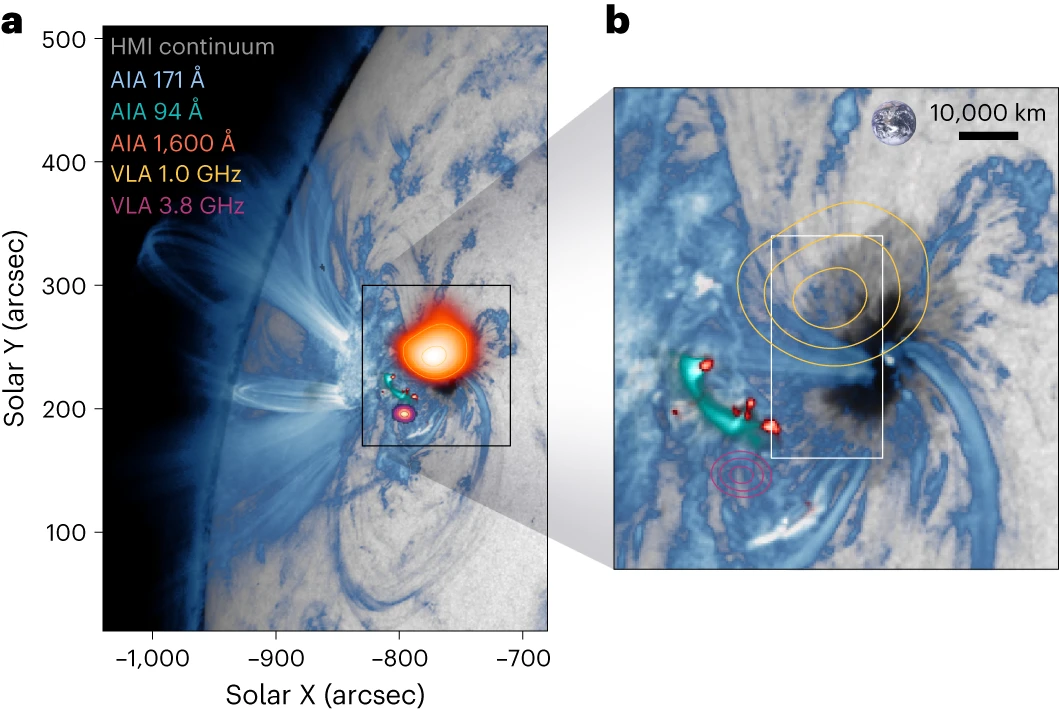Here we report observations of long-lasting solar radio bursts with high brightness temperature, wide bandwidth and high circular polarization fraction akin to these auroral and exo-auroral radio emissions, albeit two to three orders of magnitude weaker than those on certain low-mass stars. Spatially, spectrally and temporally resolved analysis suggests that the source is located above a sunspot where a strong, converging magnetic field is present.
Our findings offer new insights into the origin of such intense solar radio bursts and may provide an alternative explanation for aurora-like radio emissions on other flare stars with large starspots.
(Figure 1 caption) a, Example of a VLA snapshot image at 1.0 GHz (orange) of the radio emission from the sunspot with the image of the radio-hosting NOAA 12529 AR observed in EUV wavelengths by the AIA, 171 Å (blue), 94 Å (cyan) and 1,600 Å (red) overlaid on the photospheric image observed by the HMI aboard the SDO. Also shown is a VLA 3.8 GHz image (magenta) of the radio emission from the flare site. b, Closer view of the sunspot region (box in a). The 1.0 GHz and 3.8 GHz are shown as yellow and magenta contours, respectively, at 50%, 70% and 90% of the maximum. The white box in b is discussed further at Fig. 4.
Scientists have spotted a stunning "aurora-like" display of crackling radio waves over the surface of the sun that is strikingly similar to the Northern Lights on Earth.
"This is quite unlike the typical, transient solar radio bursts typically lasting minutes or hours," lead author Sijie Yu, an astronomer at New Jersey Institute of Technology's Center for Solar-Terrestrial Research (NJIT-CSTR), said in a statement. "It's an exciting discovery that has the potential to alter our comprehension of stellar magnetic processes."
The researchers say their discovery has opened up new ways to study the sun's activity, and they have begun poring through archival data to find hidden evidence of past solar auroras. "We're beginning to piece together the puzzle of how energetic particles and magnetic fields interact in a system with the presence of long-lasting starspots," study co-author Surajit Mondal, a solar physicist at NJIT, said in the statement. "Not just on our own Sun but also on stars far beyond our solar system."
This is a really exciting discovery! The resolution required to do this kind of work is fairly low so it seems completely plausible that past observations of the Sun in radio may have captured these sorts of effects. The duration is also interesting--a week is a long time for solar processes. Something I'm particularly curious about is whether we expect to see more of these now that a long and early solar maximum is just around the corner.
NOAA:
NOAA’s Space Weather Prediction Center (SWPC) issued a revised prediction for solar activity during Solar Cycle 25 that concludes solar activity will increase more quickly and peak at a higher level than that predicted by an expert panel in December 2019. The updated prediction now calls for Solar Cycle 25 to peak between January and October of 2024, with a maximum sunspot number between 137 and 173.
The solar maximum is a period in the solar cycle when the Sun's activity, particularly in terms of sunspots and solar flares, is at its highest. The solar cycle is an approximately 11-year cycle during which the Sun undergoes a regular pattern of changes in solar activity. This cycle is characterized by the waxing and waning of the number of sunspots on the Sun's surface.
During solar maximum, the number of sunspots is at its peak, and solar activity is generally more intense. Sunspots are temporary phenomena on the Sun's photosphere that appear as spots darker than the surrounding areas. They are associated with strong magnetic activity and are often the source of solar flares and coronal mass ejections (CMEs). It therefore seems pretty reasonable to me that we might expect more of these aurora-like transients, which seemed to form above a large sunspot.
Previously on this blog:
